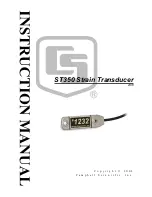
65-2331-04 H
2
S Transmitter • 5
Zero Pot
The zero pot is located in the upper left corner of the amplifier (see Figure 3). Use a small
flat blade screwdriver to turn the zero pot’s adjustment screw and adjust the amplifier’s
zero (H
2
S free) output during the start-up and calibration procedures. Turn the
adjustment screw clockwise to increase the zero output and counterclockwise to decrease
the zero output.
Span Pot
The span pot is located to the right of the zero pot (see Figure 3). Use a small flat blade
screwdriver to turn the span pot’s adjustment screw and adjust the amplifier’s response
output during the calibration procedure. Turn the adjustment screw clockwise to increase
the output and counterclockwise to decrease the output.
CAUTION:
The third potentiometer is factory-set. Do not adjust it.
Test Points
The test points (red and black) are on the left side of the amplifier (see Figure 3). The test
points produce a 100mV to 500 mV output that corresponds to the transmitter’s 4 to 20
mA output. Use the test points and a voltmeter to measure the transmitter’s output
during the start-up and calibration procedures. The black test point in the lower left
corner is the negative (-) test point and the red test point below the zero pot is the positive
(+) test point.
Amplifier Junction Box
The amplifier junction box protects the amplifier and wiring connections made to the
amplifier. Use the top 3/4” conduit hub to connect wiring from the amplifier to the
controller. Use the bottom 3/4” conduit hub to wire the remotely installed H
2
S detector.
Use the cover on the front of the junction box to access the interior of the junction box. The
amplifier is factory installed in the junction box. Three spacers installed on the back of the
junction box controls the distance of the junction box from a mounting surface.
Detector Junction Box
The detector junction box is intended to be installed remotely from the amplifier junction
box. The H
2
S detector is factory installed in the bottom 3/4” conduit hub. A terminal strip
is provided for wiring connections and the detector is factory wired to one side of this
terminal strip. The other side of the terminal strip is for user-supplied wiring to the
detector terminal strip located in the amplifier junction box. This wiring should go
through the top 3/4” conduit hub. Three spacers installed on the back of the junction box
controls the distance of the junction box from a mounting surface.










































